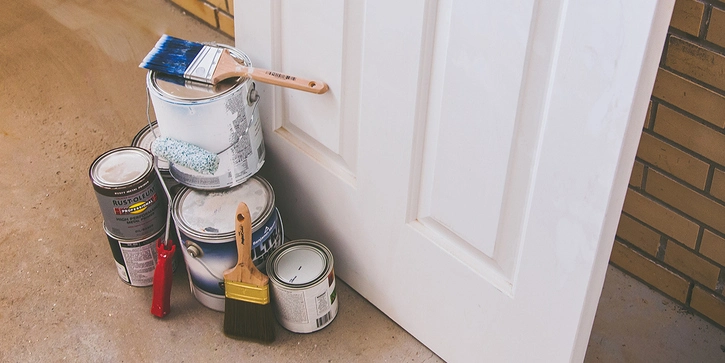Quick Tips for Painting Interior Doors

Doorways looking a little drab? Glam 'em up with a little interior paint. The best news? It’s inexpensive to paint interior doors, and you don’t have to be a professional to pull it off.
Where to Start?
Can it.
Pick-up a can of semi-gloss or glossy paint, and primer if you need it (see below). Doors undergo a lot of abuse, and shinier finishes are more durable and easy to clean. Color choices are nearly limitless, just don’t select your paint based on price alone - you may pay less for a can of paint, but you’ll spend more time applying more coats for coverage.
Stock up.
To paint interior doors, you’ll need a foam mini-roller, a one-inch brush, painters/masking tape, a drop cloth or old cardboard (per door). Read our post thoroughly and note any additional equipment you don’t currently have on-hand.
Leave it Hanging or Take it Down?
Let it hang if you’re painting by yourself:
- Or, if you don’t know how to work a screwdriver, or have the strength or space to work on a removed door, this method also lets you paint both sides at once.
- When you paint an inside door, cover all surfaces including the floor underneath and yourself! Drips and unintended bumps into wet paint can happen easily and this way you won’t ruin your work or your clothing.
- Tape it up. Grab a roll of masking or painter’s tape and carefully cover all metal components to reduce fix ups and clean up later
Take it down if you’re a perfectionist:
- You’ll get a better finish using this method.
- Remove all the parts.
- Using a screwdriver, take the hinges, knobs and other hardware off the door before painting.
- Setup your sawhorses and then place your door on them.
Prep Steps
- Scrub-a-dub. Remove any dirt or oil that will prevent adhesion when you paint an inside door, and scrape down buildup/uneven edges with a stainless steel scraper.
- Smooth things over. Fill in holes or scratches with drywall putty, then sand as necessary to ensure a smooth, polished finish.
- To prime or not to prime? Bare or stained wood should be primed, as should dark paint colors you’re trying to cover with lighter shades.
Practice Proper Paint Procedures
- Always go in the direction of the grain – never against – for professional results.
- For flat doors, start at one end and work your way down, chasing wet edges. Paint edges last. Beware of bubbles and inconsistent textures, which you can smooth with your brush.
- For paneled doors, start at the top, with the first set of two panels, beginning with the recessed part that looks like the frame of the picture. After painting each frame, use your roller to apply paint to the centerpiece (where the photo would go, if it were a picture), smoothing out blobs. Move on to the set below, and so-on until panels are complete. Next paint the vertical centerpiece, then horizontal, followed by the perimeter of the door. Paint the other side in a similar manner. Lastly, paint the edge. Check for and smooth drips, let dry 30 minutes, then repeat.
- Now... wait! We know you want to finish this task, but let the paint dry for at least two days before reinstalling and/or closing doors (especially in humid conditions).
Painting interior doors somehow leave you with a mess or don't want to tackle this task on your own? Mr. Handyman can help. Contact your local Mr. Handyman by calling or request service in your area.
 Click to call
Click to call


